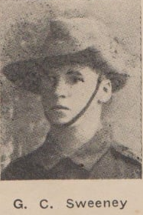
SWEENEY, George
| Service Number: | 6346 |
|---|---|
| Enlisted: | Not yet discovered |
| Last Rank: | Private |
| Last Unit: | 15th Infantry Battalion |
| Born: | Coulson, Queensland, Australia, date not yet discovered |
| Home Town: | Teviotville, Scenic Rim, Queensland |
| Schooling: | Teviotville, Queensland, Australia |
| Occupation: | Farm Hand |
| Died: | Killed in Action, France, 11 April 1917, age not yet discovered |
| Cemetery: |
No known grave - "Known Unto God" Australian National Memorial, Villers Bretonneux, France, Villers-Bretonneux Memorial, Villers-Bretonneux, Picardie, France |
| Memorials: | Australian War Memorial Roll of Honour, Boonah War Memorial, Villers-Bretonneux Memorial |
World War 1 Service
| 7 Sep 1916: | Involvement Private, 6346, 15th Infantry Battalion, --- :embarkation_roll: roll_number: '11' embarkation_place: Brisbane embarkation_ship: HMAT Clan McGillivray embarkation_ship_number: A46 public_note: '' | |
|---|---|---|
| 7 Sep 1916: | Embarked Private, 6346, 15th Infantry Battalion, HMAT Clan McGillivray, Brisbane |
Narrative
George Sweeney #6346 15th Battalion
George Sweeney enlisted in Brisbane on 28th December 1915. At least four other Boonah men enlisted on that day (Alex Merlehan, Andy McBride, David and Edward Louden) which would suggest that the Boonah community had conducted a recruiting drive.
At enlistment, George stated his age as 18 years and 3 months, a farm hand from Teviotville. He named his father Patrick as his next of kin. George would spend nine months in camp at Enoggera before finally being allocated as a reinforcement for the 15th Battalion. He departed Brisbane on 7th September 1916 on the “Clan McGillivray” and arrived in Plymouth on 2nd November.
An initial posting to the 4th Training Battalion at Rollestone was followed by arrival in France on 1st March 1917. George joined his battalion on the Somme or the first time a week later.
The spring of 1917 saw increased activity as the Germans conducted a tactical withdrawal east to heavily defended positions protected by three belts of wire and comprising machine gun posts with interlocking field of fire that could enfilade the bare ground. The 15th Battalion, as part of the 4th Division AIF had followed closely on the German heels as they withdrew and in early April found themselves facing the enemy on the Hindenburg Line at Bullecourt.
The plan, if such a fiasco could be called as such, called for troops of the 4th Division to attack across the open ground without artillery support. The general who planned this action had been convinced that a new super weapon, the tank, would crush the German wire and open up the lines for the advancing infantry. On the night of 2nd April, the battalions in the first wave moved out to the jump off tapes to await zero hour. The tanks that were to lead the assault did not make it to the start line, either because they broke down or became lost in the dark. The attack was called off and as dawn broke the infantry were called back, all in full view of the German defenders. In a move of great cunning, General Gough ordered that the same plan be used the next evening. As the troops lay on the open ground waiting for the whistles to blow, it began to snow. A few tanks made it to the start line but they were easily knocked out by artillery. As the infantry charged across the open ground, they were mown down by the machine guns. Some infantry did make it to the first line of enemy trench but they could not be supported due to the murderous machine gun fire. The uncut wire proved to be impenetrable and many men were caught up in the entanglements and shot. Messengers sent out from battalion headquarters did not return. A pigeon message timed at 7:30 am requesting ammunition and bombs (hand grenades) was not received at headquarters until 11:00pm. By then it was too late. Out of a nominal strength of almost 900, the 15th Battalion suffered almost 400 hundred casualties; killed wounded or captured.
The official report on Bullecourt stated that the attack had been “partly successful,” but did not expand on that. The official war correspondent Charles Bean wrote that the plan had as much chance of success as a plan to capture the moon. At least one battalion commander in the division refused point blank to allow his troops to be involved in any plans that involved tanks for the next 12 months and the most decorated soldier in the 4th Division, Albert Jacka VC and MC was openly scathing in his criticism. Nevertheless the architect of the Bullecourt plan, Lieutenant General Gough continued to command frontline troops and was in charge of the British 5th Army which broke and ran in the face of the German offensive on the Somme in 1918.
In May of 1917, George Sweeney’s family at Teviotville received a telegram advising that George was missing in action on 4th April 1917. No further news was forthcoming and in desperation, George’s mother Elizabeth wrote to base records in Melbourne seeking news of her son. An official Court of Inquiry was conducted in November 1917 which concluded that no trace of George was forthcoming from POW enquiries and that as a result George was then listed as Killed in Action.
No remains of George were ever located and he is commemorated on the walls of the Australian National Memorial at Villers Bretonneux, in company with over 10,000 Australians who lost their lives in France and have no known grave.
Submitted 18 August 2021 by Ian Lang










